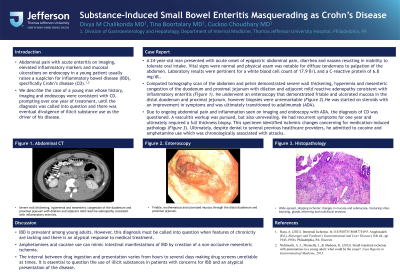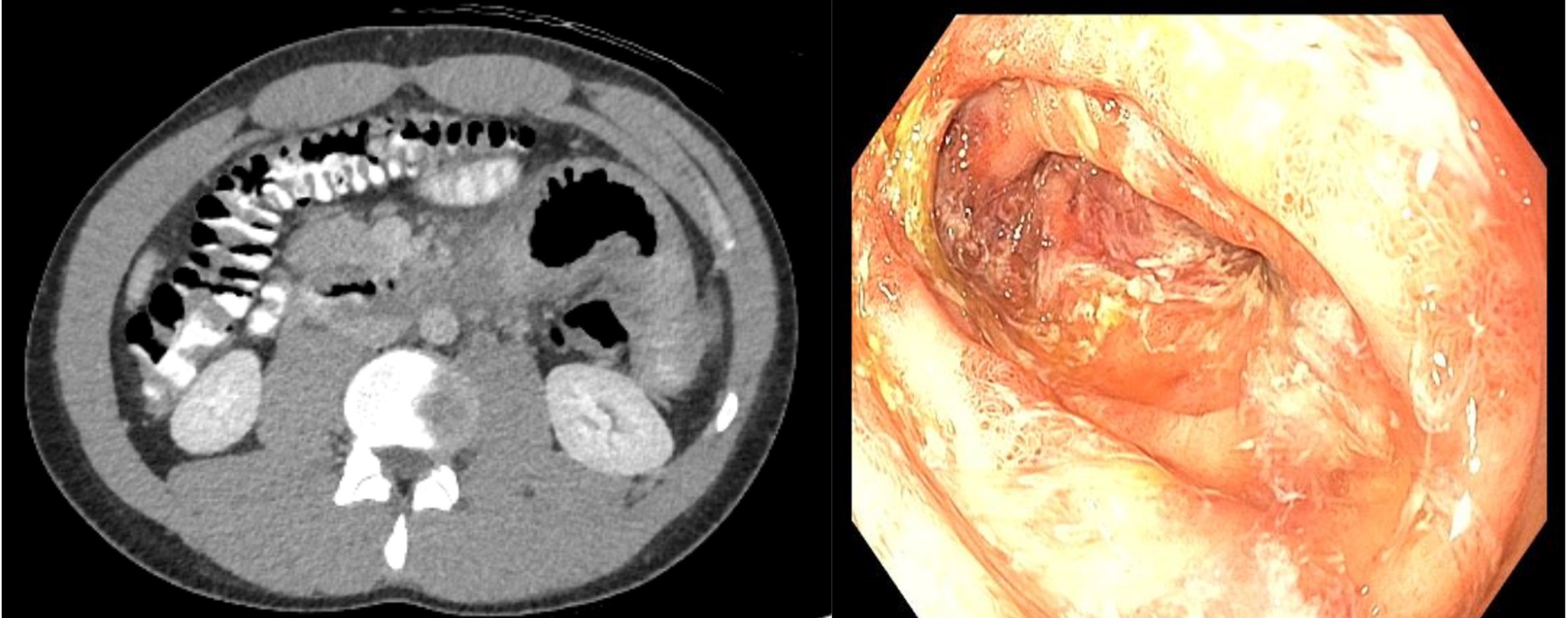Tuesday Poster Session
Category: IBD
P3656 - Substance-Induced Small Bowel Enteritis Masquerading as Crohn’s Disease
Tuesday, October 24, 2023
10:30 AM - 4:00 PM PT
Location: Exhibit Hall

Has Audio

Divya Chalikonda, MD
Thomas Jefferson University Hospital
Philadelphia, PA
Presenting Author(s)
Divya Chalikonda, MD, Tina Boortalary, MD, Cuckoo Choudhary, MD
Thomas Jefferson University Hospital, Philadelphia, PA
Introduction: Abdominal pain with acute enteritis on imaging, elevated inflammatory markers and mucosal ulcerations on endoscopy in a young patient usually raises a suspicion for inflammatory bowel disease (IBD), specifically Crohn’s disease (CD). We describe the case of a young man whose history, imaging and endoscopy were consistent with CD, prompting over one year of treatment, until the diagnosis was called into question and there was eventual divulgence of illicit substance use as the driver of his disease.
Case Description/Methods: 24-year-old man presented with acute onset of epigastric abdominal pain, diarrhea and nausea resulting in inability to tolerate oral intake. Vital signs were normal and physical exam was notable for diffuse tenderness to palpation of the abdomen. Laboratory results were pertinent for a white blood cell count of 17.9 B/L and a C-reactive protein of 6.8 mg/dL. Computed tomography scan of the abdomen and pelvis demonstrated severe wall thickening, hyperemia and mesenteric congestion of the duodenum and proximal jejunum with dilation and adjacent mild reactive adenopathy consistent with inflammatory enteritis (Figure 1A). He underwent an enteroscopy that demonstrated friable and ulcerated mucosa in the distal duodenum and proximal jejunum, however biopsies were unremarkable (Figure 1B). He was started on steroids with an improvement in symptoms and was ultimately transitioned to adalimumab (ADA). Due to ongoing abdominal pain and inflammation seen on imaging and endoscopy with ADA, the diagnosis of CD was questioned. A vasculitis workup was pursued, but also unrevealing. He had recurrent symptoms for one year and ultimately required a full thickness biopsy. This specimen identified ischemic changes concerning for medication-induced pathology. Ultimately, despite denial to several previous healthcare providers, he admitted to cocaine and amphetamine use which was chronologically associated with attacks.
Discussion: IBD is prevalent among young adults. However, this diagnosis must be called into question when features of chronicity are lacking and there is an atypical response to medical treatment. Amphetamines and cocaine use can mimic intestinal manifestations of IBD by creation of a non-occlusive mesenteric ischemia. The interval between drug ingestion and presentation varies from hours to several days making drug screens unreliable at times. It is essential to question the use of illicit substances in patients with concerns for IBD and an atypical presentation of the disease.

Disclosures:
Divya Chalikonda, MD, Tina Boortalary, MD, Cuckoo Choudhary, MD. P3656 - Substance-Induced Small Bowel Enteritis Masquerading as Crohn’s Disease, ACG 2023 Annual Scientific Meeting Abstracts. Vancouver, BC, Canada: American College of Gastroenterology.
Thomas Jefferson University Hospital, Philadelphia, PA
Introduction: Abdominal pain with acute enteritis on imaging, elevated inflammatory markers and mucosal ulcerations on endoscopy in a young patient usually raises a suspicion for inflammatory bowel disease (IBD), specifically Crohn’s disease (CD). We describe the case of a young man whose history, imaging and endoscopy were consistent with CD, prompting over one year of treatment, until the diagnosis was called into question and there was eventual divulgence of illicit substance use as the driver of his disease.
Case Description/Methods: 24-year-old man presented with acute onset of epigastric abdominal pain, diarrhea and nausea resulting in inability to tolerate oral intake. Vital signs were normal and physical exam was notable for diffuse tenderness to palpation of the abdomen. Laboratory results were pertinent for a white blood cell count of 17.9 B/L and a C-reactive protein of 6.8 mg/dL. Computed tomography scan of the abdomen and pelvis demonstrated severe wall thickening, hyperemia and mesenteric congestion of the duodenum and proximal jejunum with dilation and adjacent mild reactive adenopathy consistent with inflammatory enteritis (Figure 1A). He underwent an enteroscopy that demonstrated friable and ulcerated mucosa in the distal duodenum and proximal jejunum, however biopsies were unremarkable (Figure 1B). He was started on steroids with an improvement in symptoms and was ultimately transitioned to adalimumab (ADA). Due to ongoing abdominal pain and inflammation seen on imaging and endoscopy with ADA, the diagnosis of CD was questioned. A vasculitis workup was pursued, but also unrevealing. He had recurrent symptoms for one year and ultimately required a full thickness biopsy. This specimen identified ischemic changes concerning for medication-induced pathology. Ultimately, despite denial to several previous healthcare providers, he admitted to cocaine and amphetamine use which was chronologically associated with attacks.
Discussion: IBD is prevalent among young adults. However, this diagnosis must be called into question when features of chronicity are lacking and there is an atypical response to medical treatment. Amphetamines and cocaine use can mimic intestinal manifestations of IBD by creation of a non-occlusive mesenteric ischemia. The interval between drug ingestion and presentation varies from hours to several days making drug screens unreliable at times. It is essential to question the use of illicit substances in patients with concerns for IBD and an atypical presentation of the disease.

Figure: Figure 1A. Severe wall thickening, hyperemia and mesenteric congestion of the duodenum and proximal jejunum with dilation and adjacent mild reactive adenopathy consistent with inflammatory enteritis. Figure 1B. Friable, erythematous and ulcerated mucosa through the distal duodenum and proximal jejunum.
Disclosures:
Divya Chalikonda indicated no relevant financial relationships.
Tina Boortalary indicated no relevant financial relationships.
Cuckoo Choudhary indicated no relevant financial relationships.
Divya Chalikonda, MD, Tina Boortalary, MD, Cuckoo Choudhary, MD. P3656 - Substance-Induced Small Bowel Enteritis Masquerading as Crohn’s Disease, ACG 2023 Annual Scientific Meeting Abstracts. Vancouver, BC, Canada: American College of Gastroenterology.
